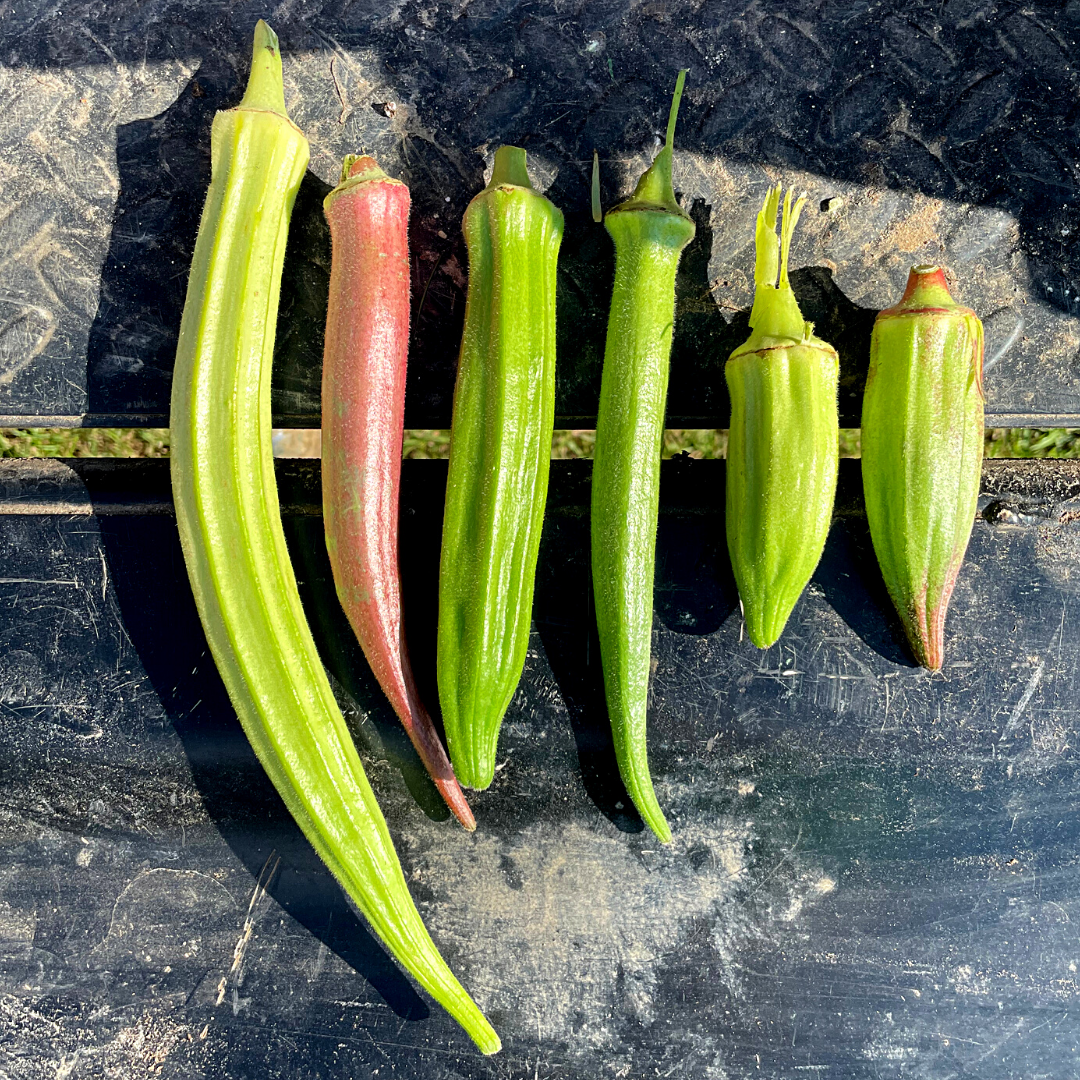After reading the book, The Whole Okra, earlier this year, I became somewhat obsessed with trying as many different varieties of okree that I could. That book mentions that there are hundreds of different okree varieties in existence, and I was quite disappointed in myself that I had only ever grown a handful. So I decided there was no better time to start than this year (2021).
When we were selling our vegetables in our weekly CSA bags, we predominantly grew the Jambalaya variety for the superior production it provided. But now that we weren't selling our vegetables, maximal production was no longer a priority. That gave us the freedom to try many different varieties that may offer some unique qualities besides being the most productive.
Due to our long growing season, we're usually able to grow three different plantings of okree. We always plant a round of okree in the spring (once soil temps warm), then another round in mid-summer, and sometimes another round in the fall. We typically transplant the first planting in spring to get a head start on the production.
TRIAL #1 - FOUR OKREE VARIETIES
Our first planting included four different varieties, each of which we had never grown (I'll include a list of all the varieties with sources at the bottom of this post). These varieties included Jing Orange, Emerald Green Velvet, Perkins Long Pod, and a family heirloom variety that a viewer sent us. That heirloom variety didn't have a name, but we decided to call it "Ruiz" okree as that was the last name of the person who sent it to us.
We learned some interesting things about those varieties in that first planting. The Jing Orange variety is highly-touted as one of the best-tasting okree varieties, and we agree! We like to use the "raw taste test" as a way to really compare the flavors of different okree varieties, and Jing Orange is a great one to enjoy raw.
We also really enjoyed the Emerald Green Velvet variety because the pods remained tender at very long lengths, which meant that we didn't have to be as diligent about harvesting it every other day. This also meant that we got more okree per harvest because a longer pod gives us more delicious okree to eat! I believe the Emerald Green Velvet variety is also commonly sold as "Louisiana Green Velvet," depending on the seed company where it's purchased.
The Perkins Long Pod variety was just okay. The pods did stay relatively tender at longer lengths than most standard varieties, but it wasn't a huge producer for us. It was substantially out-produced by the Jing Orange and Emerald Green Velvet varieties. So while it wasn't a terrible variety, it was our least favorite in that initial trial of four varieties.
As far as productivity goes, the Ruiz heirloom okree was the most productive variety of those four in the first trial. It did take longer than normal to start producing, but it was very productive once it did. It also had great flavor and the pods stayed tender to about 7" or so. I definitely want to grow this one again.

TRIAL #2 - SIX OKREE VARIETIES
Our second okree planting was done in mid-summer and those were direct-seeded. We could have transplanted them like we do in spring, but the soils are usually plenty-warm by mid-summer to get fast and reliable germination from direct-seeding. This trial included Okinawa Pink, Alabama Red, Choppee, Cajun Jewel, Burmese, and another heirloom variety sent to us by a viewer.
Before I assess these varieties, let me briefly explain some of the redeeming qualities that might make me pick one okree variety over another. These qualities might not be the same for everyone, but these are the plant and pod characteristics that I prefer:
- I like okree varieties where the plants don't get too tall, too quick. We like to prune the lateral leaves of the okree plants as they grow because it makes harvesting easier and less itchy. Some varieties get really tall, really fast when you do this, while other varieties maintain a moderate size that doesn't require a ladder for harvesting.
- Since we're no longer growing it to sell, I like okree varieties that stay tender at longer lengths. This allows me to pick it every 3-4 days as opposed to every other day. It also gives me more reward per harvest effort. It takes just as long to cut an okree pod that's 3" long as it does one that's 8-9" long.

Now that those guidelines have been established, let's dig into the second trial. I'll start with the ones that weren't my favorites. These would include the Alabama Red variety and the "fat okra" variety (I think it's the same as Star of David) that was sent by a viewer. While both are beautiful varieties that taste great, they have to be picked at a shorter length or the pods get tough. The plants also become like trees very quickly as the lateral limbs are pruned. While I appreciate their novelty, I'm not a huge fan of the short, stumpy-podded okree varieties.
The "middle of the road" variety in this second trial would be Cajun Jewel. It was a solid variety with great production and decent pod tenderness at longer lengths. But the plants really want to grow laterally, so much that this variety was much more difficult to prune than the others. The plants do stay shorter, but it appears that their naturally tendency is to become a huge, bushy, okree plant.
The Okinawa Pink variety is one where I'm not able to provide a complete, well-rounded assessment. This is because I didn't have many seeds and only had a few plants germinate due to some heavy rains after direct-seeding. But the two plants I did have produced some delicious red okree that stayed tender at longer lengths. The plants also didn't get too tall and were easy to manage.
My two favorites from this second trial were the Choppee and Burmese varieties. Choppee is a smooth-podded variety which looks much like Emerald Green Velvet. It's very productive compared to the other varieties in the trial, and some of the pods we harvested were still tender when allowed to get 10-11" long.
Burmese has ribbed pods, and stays tender at the longest lengths I've seen. Like Choppee, the plants remain small and are very manageable. But the Burmese pods get massive and stay tender even when you don't harvest them for almost a week. It was quite amazing.
HOW MANY MORE ARE THERE?!
We were able to compare 10 varieties this year, but we still have many more to go! Next year we'll plan on comparing at least 5 varieties per planting, and we'll try to do at least two plantings like we did this year.
If you have any varieties that you'd like to see us try, send us a message and we'll add it to the list. And if you have any family heirloom varieties that are unique, we'd love to try those as well. You can send us a message and we'll provide our shipping information so we can add them to one of the trials. We already have more seeds from several varieties that a viewer sent us, so we're excited to try them!
LINKS OF VARIETIES IN THE 2021 TRIALS
- Emerald Green Velvet
- Jing Orange
- Perkins Long Pod
- "Ruiz" - not available at the moment. Will update if it becomes available for sale online.
- Alabama Red
- Okinawa Pink
- Choppee
- Cajun Jewel
- Burmese
- "Fat" - not available at the moment. But we think this is the same as Star of David.

